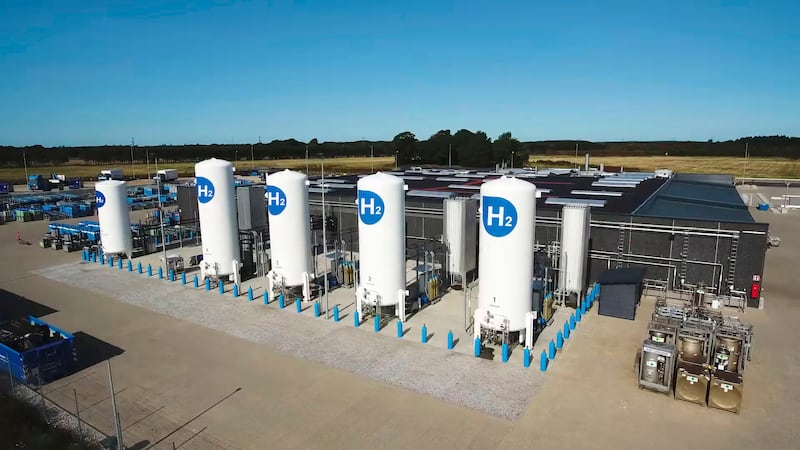To fully decarbonise power generation and maximise the benefits of renewable energy the grid will need to become far more agile and flexible. Ireland’s power system is making great strides in its transition away from fossil fuels, with wind power accounting for around a third of the country’s electricity last year. But fossil fuels are still crucial for maintaining the reliability of the electricity grid, particularly when the wind isn’t blowing, increasing cost and carbon emissions.
It is already possible to nudge electricity consumption habits to partly achieve this. For example, the roll out of electric vehicles (EVs) could either hurt or help the transition to renewable energy depending on how they’re charged: if one million EVs were simply plugged in when people return home in the evenings the grid would be put under enormous pressure and use of “peaking plants” would increase.
This can be avoided with smart meters – which record electricity used every half-hour – and tariffs that incentivise EV owners to charge at night when electricity is typically greener and less costly to produce. Under some tariffs EVs can be charged for a small fraction of what it would otherwise cost, one euro for 100km of driving range.
Long-duration energy storage solutions are still in their infancy and require further technological advancements and cost-reductions to be deployed at scale
Part of the bargain that goes with these tariffs is far more costly electricity during the evening, when the power grid typically needs to use carbon-intensive and costly “peaking plants” to meet spikes in demand. Avoiding using appliances like clothes washing and drying during that time lowers the cost of the power system for everyone, and reduces carbon emissions.
Creaking energy and water systems represent ‘reputational risk’ for Ireland, council warns
Wholesale electricity prices rose 21.7% in May on previous month
Larne gas cavern project a victim of green nimbyism and North’s administrative deadlock
Airtricity announces fresh price cuts of 10% for gas and electricity users
Smart tariffs have the potential to be an easy win for the energy transition, but they must be good value and people must understand how they work to be widely adopted and to lower peak demand. Incentives could also take a simpler form, like paying households to use less electricity when the grid is under strain.
Furthermore, EVs could greatly benefit the transition to renewables if just a fraction of their battery storage capacity was harnessed to feed electricity into the grid at times of peak demand, or when renewable generation is low.
The battery of a new EV can store enough energy to power a typical house for five days. Some new EV models have this “vehicle to grid” technology, and two electricity providers in the UK are trialling tariffs to pay households for allowing their EV battery to be used in this way. The benefits would be even greater if this were combined with EV chargers designed to use excess renewables, like rooftop solar panels: the EV battery would then become a way of storing renewable energy produced during the day for when it’s needed in the evening.

Fossil fuels are also still required to keep the grid functioning even when there is more than enough wind power to meet demand. Like the need for “peaking plants”, this raises the cost and carbon emissions of our electricity. Technologies are in the pipeline to address this, and the ESB is currently installing the world’s largest flywheel – a 177 tonne rotating mass – in Moneypoint, Co Clare to smooth out grid imbalances and replace fossil fuels with no carbon emissions.
Flexibility and storage solutions like these will become even more beneficial and necessary as wind and solar deployment is accelerated and fossil fuels for transport, heating and industry are replaced with electricity. Grid interconnection projects with France, Britain, and Northern Ireland will also bring benefits, as will the deployment of large-scale batteries.
But longer-term energy storage solutions are also required, particularly during dark, windless cold snaps in winter, called “dunkelflaute” by Germans. Wind energy produced less than 10 per cent of Ireland’s electricity during times of historically-high energy demand last month, highlighting this gap.
Along with batteries and interconnection, hydrogen may play an important role in providing clean, flexible power at these times: Ireland could build up a strategic reserve of the fuel using excess wind and solar energy through the year to save it for the proverbial rainy day. Energy could also be stored as heat underground, and pumped through district heating networks in the cold months.
But long-duration energy storage solutions are still in their infancy and require further technological advancements and cost-reductions to be deployed at scale. There is reason to be hopeful as these are the focus of big research and investment: batteries and hydrogen could become widely used by the end of this decade thanks to the same kinds of supportive public policy and innovations that led to solar PV and wind energy becoming so cheap and ubiquitous.
Hannah Daly is professor in sustainable energy at University College Cork




